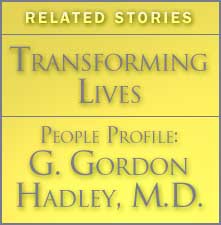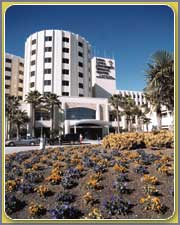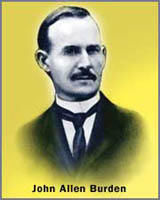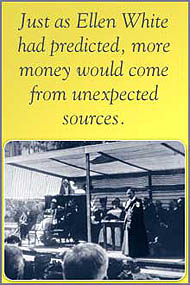BY KEN MCFARLAND
 S EARLY AS 1875 A GROUP OF INVESTORS discovered a low hill rising from the valley floor south of San Bernardino in southern California--and dreamed of creating a planned city. With reference to the small hill, they called themselves the Mound City Land Association. Low interest rates, a burgeoning citrus industry, and new rail connections fueled optimism for the speculators, who foresaw a possible boomtown in the making.
S EARLY AS 1875 A GROUP OF INVESTORS discovered a low hill rising from the valley floor south of San Bernardino in southern California--and dreamed of creating a planned city. With reference to the small hill, they called themselves the Mound City Land Association. Low interest rates, a burgeoning citrus industry, and new rail connections fueled optimism for the speculators, who foresaw a possible boomtown in the making.
But not all dreams come true. The plans for Mound City failed. Within a year the post office closed. In 1882 a Mr. H. E. Hills bought 267 acres from the Mound City Association. Mr. Hills (no irony intended) built his home on the mound itself, and turned much of his remaining land into a large farm he called Mound City Ranch. By late 1886 deteriorating health led Mr. Hills to sell his property to yet another investor group for $30,500. They quickly formed a corporation called the Mound City Land and Water Company.
This new investor group also dreamed of creating a boomtown. Farmers all through the valley were growing rich--not so much from their farming as from buying and selling land. It was common for a parcel of land to double in price and change owners several times in a single day. In early 1887 the two big railways--Southern Pacific and Santa Fe--began a fare war on the Kansas City to Los Angeles route. Ticket rates fell steadily and swiftly from $125 to just $1.
 The developers of the old Mound City Ranch were convinced their investment would pay off handsomely. They retained the name Mound City, intent on luring business to the new development. On the summit of that mound they invested $40,000 to build an ornate, five-story Victorian-style wooden hotel.
The developers of the old Mound City Ranch were convinced their investment would pay off handsomely. They retained the name Mound City, intent on luring business to the new development. On the summit of that mound they invested $40,000 to build an ornate, five-story Victorian-style wooden hotel.
But no investment is without risk. The Mound City planners had hardly finished the hotel when the building boom collapsed, owing at least in part to the arrival of a prolonged, intermittent drought. Then came the depression of 1893, forcing Mound City's developers to abandon their plans and put the land on the market. By the turn of the twentieth century Mound City and its hotel stood vacant.
In time yet another group--composed of 80 physicians and 40 businessmen--saw new possibilities as they looked over the parcel of land that had aroused the dreams of so many others before them. This consortium of doctors and business investors decided to convert the hotel and its surroundings into a health resort. The 120 investors renamed the property Loma Linda (Spanish for "Hill Beautiful"). In September of 1900 the Loma Linda Association filed its Articles of Incorporation. The following month they began transactions to purchase the land for $15,000. Once in their possession, the investors poured an additional $155,000 into Loma Linda, intending to bring their new health resort to the front ranks of the many such developments in southern California. Aggressively promoted, a Loma Linda brochure touted the resort as "The Switzerland of California, where health and pleasure are twins."
It seemed as if fortune were finally ready to smile on the mounded tract of land in the great inland valley. But again, success slipped from the grasp of yet another group of optimistic owners. Sometimes the resort had no guests at all. Amazingly, in 1904 the owners reluctantly offered the property for sale for a price that represented a major loss on their investment: $110,000. In April of 1905 the doors of Loma Linda closed. Area residents called the place "Lonesome Linda."
Might it be that Lonesome Linda, beset by the serially dashed dreams of its successive owners, would even yet realize some special destiny?
Lonesome No More
As it happened, half a state away to the north near the Napa Valley's little town of St. Helena, the eventual destiny of Loma Linda was stirring in the mind and heart of a woman named Ellen G. White. In 1901 she had described a southern California property she had seen in vision on which the church would build a medical institution, and on which were great shade trees to form a massive tentlike canopy over patients in wheelchairs enjoying the benefits of fresh outdoor air. Ellen White knew the property was somewhere to be found--but where?
The Loma Linda property matched that description, but in 1901 it was still occupied and not for sale.
Enter now a young Adventist minister named John Allen Burden. Mrs. White had been greatly impressed by this gifted pastor, who at the age of 29 had managed the St. Helena Sanitarium in northern California near her home.
 Convinced that the property she had previewed in her vision existed, Ellen White asked church members to start looking between Riverside, San Bernardino, and Redlands. Pastor Burden was himself now in southern California. Being a devout believer in Ellen White's leadership and prophetic gift, Burden took her request to heart and began actively looking in the area.
Convinced that the property she had previewed in her vision existed, Ellen White asked church members to start looking between Riverside, San Bernardino, and Redlands. Pastor Burden was himself now in southern California. Being a devout believer in Ellen White's leadership and prophetic gift, Burden took her request to heart and began actively looking in the area.
A local Adventist pastor first located the Loma Linda property. In May of 1905 John Burden reported to Ellen White that he had evaluated the tract of 76 acres a few miles west of Redlands, and that it appeared to match her description. The caretaker of the Loma Linda property told Pastor Burden that though $155,000 had been invested in the land and its buildings (an astonishing $3.1 million in the currency of a century later), it could be purchased for $110,000.
This was out of the question for an already debt-laden membership. Only recently they had purchased two other southern California properties that would become today's Paradise Valley Hospital and Glendale Adventist Medical Center--and they were now under strict direction to get out of debt.
Later the price for the Loma Linda property came down to $85,000. At this point Ellen White wrote a letter dated April 12, 1905, to the church members in southern California. In this letter she urged them: "Arouse, and avail yourselves of the opportunities open to you."1
Soon afterward the price dropped again to $45,000. When Pastor Burden relayed this information to Ellen White, she advised him to stay close to the situation and keep her posted.
Proactive by nature, the young pastor approached the owners again to see if he could determine their rock-bottom price. They quoted him a price of $40,000, firm, with only a few days' option to buy at this price.
"What shall we do?" he asked Ellen White. "We must act at once, for the [Loma Linda Association] is anxious to sell, and there are others who want it."2 Pastor Burden suggested that she confer with conference leaders.
Based on a confirming vision she had received the night before, she asked her son W. C. White ("Willie") to telegram Pastor Burden to immediately secure the option to purchase the Loma Linda property. "I advised Willie to send you a telegram without spending time to ask the advice of the brethren. Secure the property by all means, so that it can be held, and then obtain all the money you can and make sufficient payments to hold the place. This is the very property we ought to have. Do not delay; for it is just what is needed. . . . We will do our utmost to help you raise the money."3
Meanwhile, members of the local conference committee, who were meeting at the time in Washington, D.C., wired Pastor Burden to say, "Developments here warrant advising do not make deposit on sanitarium."4 John Burden found himself caught squarely in the middle between Ellen White and "the brethren."
 With money donated by a Los Angeles farmer, Pastor Burden put down a $1,000 deposit to hold the property, and on May 29, 1905, signed papers. Local Adventists gave another $4,000 to complete the first payment on June 15. Additional payments were due in July, August, and December, with the balance to be secured by a three-year mortgage.
With money donated by a Los Angeles farmer, Pastor Burden put down a $1,000 deposit to hold the property, and on May 29, 1905, signed papers. Local Adventists gave another $4,000 to complete the first payment on June 15. Additional payments were due in July, August, and December, with the balance to be secured by a three-year mortgage.
On July 26, 1905, the due date for the second payment, the conference committee of the Southern California Conference met in emergency session in Los Angeles. The second installment, $5,000, was due at 2:00 p.m. They didn't have the first dollar of it. Some members again were openly critical of the plan to purchase the property. John Burden later reported that "the intensity of feelings was running high," and that they were "in deep perplexity."
Someone suggested that the troubled group wait for the morning mail. Soon they heard the postman walking up the stairs. The mail included a letter from a woman in Atlantic City, New Jersey. The sender was unknown to anyone on the committee, and is unknown to this day. The letter had traveled, possibly for weeks, across the North American continent. Inside was a note saying, "I do not know just what your immediate need is, but if this will help, use it"--and a bank draft for $5,000, the exact amount needed four hours later on that deadline day. There wasn't a dry eye in the place. John Burden later reported, "It was as solemn as the judgment day. . . . We then took new courage, as we felt that our Lord was going before us."
Just as Ellen White had predicted, more money would come from unexpected sources. Through a series of truly remarkable providences, the entire sum was paid in full within another six months, bringing a discount of $1,100. Thus, for a purchase price of $38,900 (plus $7,000 in interest and taxes), southern California Adventists now possessed their third property for medical work.
Confirmation
Two weeks after John Burden signed the first papers on Loma Linda, Ellen White visited the property for the first time on June 12, 1905. Arriving with her son by express wagon from Redlands, she looked at the main building and said, "Willie, I have been here before."
"No, Mother," Willie responded, "you have never been here."
"Then this is the very place the Lord has shown me, for it is all familiar," she answered. Turning to one of the ministers, she added, "We must have this place. We should reason from cause to effect. The Lord has not given us this property for any common purpose."5
 On August 22, 1905, Ellen White wrote in a personal letter that "this is the most delightful situation for a sanitarium I have ever seen. The scenery is magnificent, and everything possible has been done to beautify the premises."6
On August 22, 1905, Ellen White wrote in a personal letter that "this is the most delightful situation for a sanitarium I have ever seen. The scenery is magnificent, and everything possible has been done to beautify the premises."6
On August 24, 1905, John Burden signed the Articles of Incorporation as the president of the new Loma Linda Sanitarium. He and Ellen White immediately began an aggressive recruiting effort. In October the Sanitarium admitted its first patients.
But Ellen White had seen that Loma Linda was to be not only a sanitarium but also an educational center. In December of that year Loma Linda accepted its first students into the nursing program. But Ellen White counseled that physicians too should be trained at Loma Linda. And in 1906 the Loma Linda College of Evangelists opened its doors.
From its providential founding, the College of Evangelists went on to become the College of Medical Evangelists, known by Adventists for decades as CME. It became Loma Linda University in 1961.
Through the early years when its very existence was threatened by outward circumstances, such as world wars and the Great Depression, as well as by internal struggles to attain accreditation, the guiding hand of Loma Linda's true Founder was constantly evident. Repeatedly, a crisis of "Red Sea" proportions would arise, only for prayer and faith to enjoy the reward of divine intervention.
Could John Burden, Ellen White, and the other pioneers who sacrificed to help found Loma Linda see its campus today, they unquestionably would be both astonished and filled with gratitude to the God whose providential leading has been so evident throughout its first century of ministry.
Continuing to Lead
Loma Linda has gone on not only to survive but to thrive. From little more than faith in a dream, it has become today a sprawling, vital center of education and healing that has touched and changed lives around the world.
Loma Linda University's eight professional schools, its primary faculty of 1,000, and its student body nearing 5,000 equip successive generations to spread across the globe to carry out the mission of their alma mater: "To Make Man Whole."
Loma Linda University Medical Center's main hospital, Proton Treat-ment Center, Children's Hospital, Cancer Institute, and Transplantation Institute are only a few of the avenues by which Loma Linda reaches out to its 33,000 annual inpatients and approximately half million annual outpatients.
Yet for all its growth and diversity, Loma Linda today remains just as single-mindedly committed to its original mission as ever before. And it is just as consciously dependent on the providential blessing of its Founding Teacher and Healer.
As Loma Linda University Adventist Health Sciences Center--which includes the ministry of educating through Loma Linda University, and the ministry of healing through Loma Linda University Medical Center--enters its second century, what surprises, miracles, and accomplishments lie ahead? Most assuredly, those involved in the mission of the Hill Beautiful will continue to have challenging new mountains yet to climb.
_________________________
1 Loma Linda Messages, p. 2.
2 Arthur L. White, The Later Elmshaven Years, p. 13.
3 Ibid., pp. 15, 16.
4 Richard A. Schaefer, Legacy, p. 87.
5 A. L. White, The Later Elmshaven Years,
p. 18.
6 Ellen G. White to W. J. Stone, letter 249, 1905.
_________________________
Ken McFarland, author of the upcoming centennial history of Loma Linda University Adventist Health Sciences Center, is president of Legacy Commemorative Editions in Vancouver, Washington.
Author



